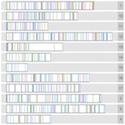 In a new paper my colleagues and I carried on our work using a mutation accumulation experiment to study the basic properties of mutation. Mutation is an important biological process because it generates genetic diversity. That includes good genetic variation that underpins evolutionary change and bad genetic variation that creates genetic diseases like cancer. Surprisingly we don't actually know that much about mutation in natural circumstances - the main reason that mutation is understudied is that individual mutations are really rare -- in humans 1 in 100 million sites will change in a generation.
In a new paper my colleagues and I carried on our work using a mutation accumulation experiment to study the basic properties of mutation. Mutation is an important biological process because it generates genetic diversity. That includes good genetic variation that underpins evolutionary change and bad genetic variation that creates genetic diseases like cancer. Surprisingly we don't actually know that much about mutation in natural circumstances - the main reason that mutation is understudied is that individual mutations are really rare -- in humans 1 in 100 million sites will change in a generation.
In this study, published in Genome Research, we allowed mutations to accumulate in 85 experimental lines of Chlamydomonas reinhardtii - a single celled alga with a genome similar to the human genome. When we sequenced their genomes we found mutation rate variation between individuals - in fact the strain with the highest mutation rate had a rate 7 times that of the the strain with the lowest mutation rate. We also found that a few of the 85 experimental lines acquired new mutations that made more mutations build up at even higher rates - so called 'mutators'.
When we looked at the distribution of mutations across the genome we found no evidence for large-scale variation in mutation rate - that means that we look at large regions of the genome they have on average the same mutation rate. Interestingly, we found that the genomic properties of individual sites did predict variation in mutation rate. For example - depending on the DNA sequence surrounding a site the mutation rate can vary by 17-fold.
This work shows us that mutations don't occur uniformly across the genome - some regions may accumulate mutations much faster than others, and some individuals might experience many more mutations than others. In the near future my lab will be applying our new understanding of mutation in Chlamydomonas to understand how the genome changes through evolutionary time.
